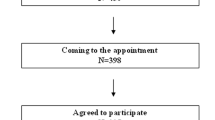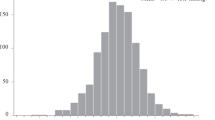Abstract
The objective of this study was to determine the normal values and characteristics of 24-h ambulatory blood pressure (ABP) and to describe the ABP level of treated hypertensive subjects in an older Finnish population. ABP was measured in 502 randomly selected subjects aged 64 years or over living in a Finnish municipality (mean age 70 years, range 64–87 years). A total of 211 subjects did not have blood pressure (BP) affecting medication. ABP measurements were taken every 30 min for 24 h, and the day- and night-time periods were diary-based. The results were that in untreated subjects, the average office BP was 134/82 ± 16/9 (s.d.) mm Hg for men and 140/81 ± 18/8 mm Hg for women. The 24-h average BP was 120/75 ± 14/8 mm Hg (95th percentile upper limit 145/93 mm Hg) for men and 125/75 ± 15/7 (95th = 154/89 mm Hg) for women. The daytime averages were 127/78 ± 12/7 mm Hg (95th = 154/99 mm Hg) and 131/78 ± 15/7 mm Hg (95th = 158/91 mm Hg) for men and women, respectively. The ABP daytime value of 130/83 mm Hg corresponded best to the office BP value of 140/90 mm Hg. All BP values were significantly higher in the treated hypertensive group compared to the normotensive group. Night-time BP was markedly lower than daytime BP, and no difference in circadian variability was found between the normotensive and hypertensive subjects. Both office and ambulatory BPs were significantly higher in women than in men. This study provides sex-specific normal values for ABP in a 64 to 87-year-old age group. The normal values of ABP were markedly lower than the office BP values. Hypertensives, even when treated, tended to have elevated values.
This is a preview of subscription content, access via your institution
Access options
Subscribe to this journal
Receive 12 digital issues and online access to articles
$119.00 per year
only $9.92 per issue
Buy this article
- Purchase on Springer Link
- Instant access to full article PDF
Prices may be subject to local taxes which are calculated during checkout




Similar content being viewed by others
References
Vokonas PS, Kannel WB, Cupples LA . Epidemiology and risk of hypertension in the elderly: the Framingham Study J Hypertens Suppl 1988 6: S3–S9
SHEP Cooperative Research Group. Prevention of stroke by antihypertensive drug treatment in older persons with isolated systolic hypertension. Final results of the Systolic Hypertension in the Elderly Program (SHEP) JAMA 1991 265: 3255–3264
MRC Working Party. Medical Research Council trial of treatment of hypertension in older adults: principal results BMJ 1992 304: 405–412
Dahlof B et al. Morbidity and mortality in the Swedish Trial in Old Patients with Hypertension (STOP-Hypertension) Lancet 1991 338: 1281–1285
Staessen JA et al. Ambulatory pressure decreases on long-term placebo treatment in olderpatients with isolated systolic hypertension. Syst-Eur Investigators J Hypertens 1994 12: 1035–1039
Mancia G et al. Ambulatory blood pressure is superior to clinic blood pressure in predicting treatment-induced regression of left ventricular hypertrophy. SAMPLE Study Group. Study on Ambulatory Monitoring of Blood Pressure and Lisinopril Circulation 1997 95: 1464–1470
Perloff D, Sokolow M, Cowan R . The prognostic value of ambulatory blood pressures JAMA 1983 249: 2792–2798
Verdecchia P et al. Prognostic significance of the white coat effect Hypertension 1997 29: 1218–1224
Staessen JA et al. Predicting cardiovascular risk using conventional vs ambulatory blood pressure in olderpatients with systolic hypertension. Systolic Hypertension in Europe Trial Investigators JAMA 1999 282: 539–546
Imai Y et al. Ambulatory blood pressure of adults in Ohasama, Japan Hypertension 1993 22: 900–912
Mancia G et al. Ambulatory blood pressure normality: results from the PAMELA study J Hypertens 1995 13: 1377–1390
O'Brien E et al. Twenty-four-hour ambulatory blood pressure in men and women aged 17 to 80 years: the Allied Irish Bank Study J Hypertens 1991 9: 355–360
Rasmussen SL, Torp-Pedersen C, Borch-Johnsen K, Ibsen H . Normal values for ambulatory blood pressure and differences between casual blood pressure and ambulatory blood pressure: results from a Danish population survey J Hypertens 1998 16: 1415–1424
Schettini C et al. Ambulatory blood pressure: normality and comparison with other measurements. Hypertension Working Group Hypertension 1999 34: 818–825
Sega R et al. Ambulatory and home blood pressure normality in the elderly: data from the PAMELA population Hypertension 1997 30: 1–6
Perloff D et al. Human blood pressure determination by sphygmomanometry Circulation 1993 88: 2460–2470
O'Brien E . Automated blood pressure measurement: state of the market in 1998 and the need for an international validation protocol for blood pressure measuring devices Blood Press Monit 1998 3: 205–211
Wendelin-Saarenhovi M et al. Long-term reproducibility of ambulatory blood pressure in unselected elderly subjects Clin Physiol 2001 21: 316–322
1999 World Health Organization. International Society of Hypertension Guidelines for the Management of Hypertension. Guidelines Subcommittee J Hypertens 1999 17: 151–183
SAS/STAT user's guide 1999 (Release 8.1 ed) SAS Institute Inc, Cary, NC, USA
Ohkubo T et al. Reference values for 24-hour ambulatory blood pressure monitoring based on a prognostic criterion: the Ohasama Study Hypertension 1998 32: 255–259
Mancia G et al. Alerting reaction and rise in blood pressure during measurement by physician and nurse Hypertension 1987 9: 209–215
Pickering TG et al. How common is white coat hypertension? JAMA 1988 259: 225–228
Siegel WC, Blumenthal JA, Divine GW . Physiological, psychological, and behavioral factors and white coat hypertension Hypertension 1990 16: 140–146
Verdecchia P et al. Variability between current definitions of ‘normal’ ambulatory blood pressure. Implications in the assessment of white coat hypertension Hypertension 1992 20: 555–562
Kumpusalo E, Parnanen H, Takala J . Treatment situation of hypertensivepatients in Finnish primary health care Blood Press Suppl 1997 1: 35–39
Imai Y et al. Circadian blood pressure variations under different pathophysiological conditions J Hypertens Suppl 1990 8: S125–S132
Pickering TG et al. Blood pressure during normal daily activities, sleep, and exercise. Comparison of values in normal and hypertensive subjects JAMA 1982 247: 992–996
Staessen JA et al. Ambulatory blood pressure and blood pressure measured at home: progress report on a population study J Cardiovasc Pharmacol 1994 23 (Suppl 5): S5–S11
Aromaa A . Epidemiology and Public Health Impact of High Blood Pressure in Finland. (In Finnish, summary in English ) Publications of the Social Incurance Institution AL: 17, Helsinki 1981
Acknowledgements
This work was supported by the Turku University Central Hospital Research Fund, Ida Montin Foundation, Finnish Cultural Foundation and Finnish Society of Clinical Physiology.
Author information
Authors and Affiliations
Corresponding author
Rights and permissions
About this article
Cite this article
Wendelin-Saarenhovi, M., Isoaho, R., Hartiala, J. et al. Ambulatory blood pressure characteristics in normotensive and treated hypertensive older people. J Hum Hypertens 16, 177–184 (2002). https://doi.org/10.1038/sj.jhh.1001318
Received:
Revised:
Accepted:
Published:
Issue Date:
DOI: https://doi.org/10.1038/sj.jhh.1001318
Keywords
This article is cited by
-
Ambulatory blood pressure: associations with coronary heart disease in the aged Finnish population
Aging Clinical and Experimental Research (2007)



